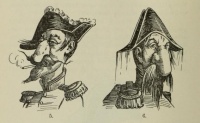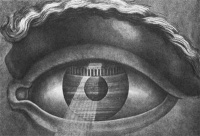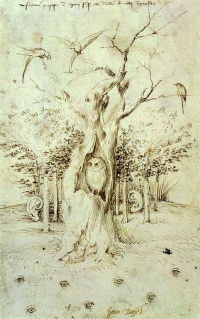Sense
From The Art and Popular Culture Encyclopedia
| Revision as of 17:09, 5 September 2012 Jahsonic (Talk | contribs) ← Previous diff |
Revision as of 19:35, 19 May 2014 Jahsonic (Talk | contribs) Next diff → |
||
| Line 1: | Line 1: | ||
| + | [[Image:Napoleon III nose caricatures from Schneegans History of Grotesque Satire.jpg|left|thumb|200px|Caricature of human nose<br> | ||
| + | Illustration: [[Napoleon III]] nose caricatures from Schneegans's ''[[History of Grotesque Satire]]'' ]] | ||
| + | {| class="toccolours" style="float: left; margin-left: 1em; margin-right: 2em; font-size: 85%; background:#c6dbf7; color:black; width:30em; max-width: 40%;" cellspacing="5" | ||
| + | | style="text-align: left;" | | ||
| + | "[[To arrive at the unknown through the disordering of all the senses, that's the point]]'. --Arthur Rimbaud, 1871 | ||
| + | <hr> | ||
| + | "(W)ith five feeble [[sense]]s we pretend to comprehend the boundlessly complex [[cosmos]], yet other beings with a wider, stronger, or different range of senses might not only see very differently the things we see, but might see and study whole worlds of matter, energy, and life which lie close at hand yet can never be detected with the senses we have ... strange, [[inaccessible]] worlds exist at our very elbows." --"[[From Beyond (short story)|From Beyond]]", H. P. Lovecraft | ||
| + | |} | ||
| + | [[Image:Nicolas Ledoux.jpg|thumb|200px|This page '''{{PAGENAME}}''' is part of the ''[[perception]]'' series. | ||
| + | <br><small> | ||
| + | Illustration: Drawing for the interior view of the [[Théatre de Besançon]] (1784) by [[Claude Nicolas Ledoux]]</small>]][[Image:Ears from 'Italian Painters'.jpg|thumb|right|200px|[[Ear]]s from ''[[Italian Painters]]'']] | ||
| + | [[Image:The Trees Have Ears and the Field Has Eyes by Hieronymus Bosch.jpg|thumb|right|200px|[[The Trees have Ears and the Field has Eyes|''The Trees have Ears and the Field has Eyes'' by Hieronymus Bosch]]]] | ||
| {{Template}} | {{Template}} | ||
| + | '''Senses''' are [[physiological]] capacities of [[organism]]s that provide data about the [[world]]; [[sight]], [[smell]], [[hearing]], [[touch]], [[taste]]. The senses and their operation, classification, and theory are overlapping topics studied by a variety of fields, most notably [[neuroscience]], [[cognitive psychology]] (or [[cognitive science]]), and [[philosophy of perception]]. The [[nervous system]] has a specific [[sensory system]] or organ, dedicated to each sense. | ||
| - | '''Senses''' are [[physiological]] capacities of [[organism]]s that provide data for [[perception]]. The senses and their operation, classification, and theory are overlapping topics studied by a variety of fields, most notably [[neuroscience]], [[cognitive psychology]] (or [[cognitive science]]), and [[philosophy of perception]]. The [[nervous system]] has a specific [[sensory system]] or organ, dedicated to each sense. | + | Human beings have a multitude of senses. Sight (ophthalmoception), [[hearing]] (audioception), taste (gustaoception), smell (olfacoception or olfacception), and touch (tactioception) are the five traditionally recognized. While the ability to detect other stimuli beyond those governed by the traditional senses exists, including temperature (thermoception), kinesthetic sense (proprioception), pain (nociception), balance (equilibrioception), acceleration (kinesthesioception), and various internal stimuli (e.g. the different chemoreceptors for detecting salt and carbon dioxide concentrations in the blood), only a small number of these can safely be classified as separate senses in and of themselves. What constitutes a sense is a matter of some debate, leading to difficulties in defining what exactly a sense is. |
| - | + | ||
| - | Human beings have a multitude of senses. Sight (ophthalmoception), hearing (audioception), taste (gustaoception), smell (olfacoception or olfacception), and touch (tactioception) are the five traditionally recognized. Whilst the ability to detect other stimuli beyond those governed by the traditional senses exists, including temperature (thermoception), kinesthetic sense (proprioception), pain (nociception), balance (equilibrioception), acceleration (kinesthesioception), and various internal stimuli (e.g. the different chemoreceptors for detecting salt and carbon dioxide concentrations in the blood), only a small number of these can safely be classified as separate senses in and of themselves. What constitutes a sense is a matter of some debate, leading to difficulties in defining what exactly a sense is. | + | |
| - | + | ||
| - | Animals also have receptors to sense the world around them, with degrees of capability varying greatly between species. Humans have a comparatively weak sense of smell, whilst some animals may lack one or more of the traditional five senses. Some animals may also intake and interpret sensory [[Stimulus (psychology)|stimuli]] in very different ways. Some species of animals are able to sense the world in a way that humans cannot, with some species able to sense [[electrical field|electrical]] and [[magnetic field]]s, and detect [[water pressure]] and currents. | + | |
| ==Culture== | ==Culture== | ||
| - | The traditional five senses are enumerated as the "five material faculties" (''{{IAST|pañcannaṃ indriyānaṃ avakanti}}'') in Buddhist literature. They appear in allegorical representation as early as in the [[Katha Upanishad]] (roughly 6th century BC), as five horses drawing the "[[chariot]]" of the body, guided by the mind as "chariot driver". | + | In the time of [[William Shakespeare]], there were commonly reckoned to be '''five wits''' or '''five senses'''. At that time, the words "sense" and "wit" were synonyms, so the senses were known as the five outward wits. This traditional concept of five senses is common today, and [[Extrasensory perception]] is often called the sixth sense. |
| - | + | ||
| - | Depictions of the five traditional senses as [[allegory]] became a popular subject for seventeenth-century artists, especially among [[Dutch Golden Age painting|Dutch]] and [[Flemish Baroque painter]]s. A typical example is [[Gérard de Lairesse]]'s ''Allegory of the Five Senses'' (1668), in which each of the figures in the main group allude to a sense: Sight is the reclining boy with a [[convex mirror]], hearing is the [[cupid]]-like boy with a [[Triangle (instrument)|triangle]], smell is represented by the girl with flowers, taste is represented by the woman with the fruit, and touch is represented by the woman holding the bird. | + | |
| - | + | ||
| - | + | ||
| + | Depictions of the five traditional senses as [[allegory]] -- called [[allegory of the senses]] -- became a popular subject for seventeenth-century artists, especially among [[Dutch Golden Age painting|Dutch]] and [[Flemish Baroque painter]]s. A typical example is [[Gérard de Lairesse]]'s ''[[Allegory of the Five Senses]]'' (1668), in which each of the figures in the main group allude to one particular sense. There is also ''[[Allegory of the Senses]]'', a painting by Jan Brueghel the Elder. | ||
| ===See also=== | ===See also=== | ||
| Line 25: | Line 31: | ||
| *[[equilibrioception]] | *[[equilibrioception]] | ||
| *[[proprioception]] | *[[proprioception]] | ||
| + | |||
| + | ==Namesakes== | ||
| + | * ''[[The Logic of Sense ]]'' (1969) by Gilles Deleuze | ||
| + | * ''[[In the Realm of the Senses]]'' (1976), a Japanese film | ||
| + | |||
| + | ==Further reading== | ||
| + | * ''[[The Man Who Mistook His Wife for a Hat]]'' (1985) by [[Oliver Sacks]] | ||
| + | |||
| ==See also== | ==See also== | ||
| * [[Attention]] | * [[Attention]] | ||
| * [[Apperception]] | * [[Apperception]] | ||
| - | * [[Āyatana]] (Sense Bases in Theravada Buddhism) | ||
| * [[Basic taste]]s | * [[Basic taste]]s | ||
| - | * [[Chemesthesis]] | ||
| * [[Communication]] | * [[Communication]] | ||
| * [[Empiricism]] | * [[Empiricism]] | ||
| * [[Extrasensory perception]] | * [[Extrasensory perception]] | ||
| * [[Hypersensitivity]] (people with unusual sense abilities) | * [[Hypersensitivity]] (people with unusual sense abilities) | ||
| - | ** [[Human echolocation]] | ||
| - | ** [[Supertaster]] | ||
| - | ** [[Entoptic phenomenon|Vision-related]]: | ||
| - | ***[[Haidinger's brush]] (ordinary people sensing light polarisation) | ||
| - | ***[[Tetrachromat]] (increased colour perception) | ||
| * [[Illusion]]s | * [[Illusion]]s | ||
| - | ** [[Auditory illusion]] | ||
| - | ** [[Optical illusion]] | ||
| - | ** [[Touch illusion]] | ||
| * [[intuition (knowledge)|Intuition]] | * [[intuition (knowledge)|Intuition]] | ||
| - | * [[Multimodal integration]] | + | * [[Nonsense]] and [[common sense]] |
| * [[Perception]] | * [[Perception]] | ||
| * [[Phantom limb]] | * [[Phantom limb]] | ||
| - | * [[Ṣaḍāyatana|Saḷāyatana]] and [[Ayatana]] (the six senses as a concept in [[Buddhism]]) | ||
| * [[Sensation and perception psychology]] | * [[Sensation and perception psychology]] | ||
| * [[Sense of time]] | * [[Sense of time]] | ||
| * [[Sensitivity (human)]] | * [[Sensitivity (human)]] | ||
| * [[Sensorium]] | * [[Sensorium]] | ||
| - | * [[Sensory Processing Disorder]] | ||
| * [[Sensory system]] | * [[Sensory system]] | ||
| + | * [[Sensor]] | ||
| * [[Synesthesia]] | * [[Synesthesia]] | ||
| - | + | * [[Word sense]] in linguistics, one of the meanings of a word | |
| {{GFDL}} | {{GFDL}} | ||
Revision as of 19:35, 19 May 2014

Illustration: Napoleon III nose caricatures from Schneegans's History of Grotesque Satire
|
"To arrive at the unknown through the disordering of all the senses, that's the point'. --Arthur Rimbaud, 1871 "(W)ith five feeble senses we pretend to comprehend the boundlessly complex cosmos, yet other beings with a wider, stronger, or different range of senses might not only see very differently the things we see, but might see and study whole worlds of matter, energy, and life which lie close at hand yet can never be detected with the senses we have ... strange, inaccessible worlds exist at our very elbows." --"From Beyond", H. P. Lovecraft |

Illustration: Drawing for the interior view of the Théatre de Besançon (1784) by Claude Nicolas Ledoux
|
Related e |
|
Featured: |
Senses are physiological capacities of organisms that provide data about the world; sight, smell, hearing, touch, taste. The senses and their operation, classification, and theory are overlapping topics studied by a variety of fields, most notably neuroscience, cognitive psychology (or cognitive science), and philosophy of perception. The nervous system has a specific sensory system or organ, dedicated to each sense.
Human beings have a multitude of senses. Sight (ophthalmoception), hearing (audioception), taste (gustaoception), smell (olfacoception or olfacception), and touch (tactioception) are the five traditionally recognized. While the ability to detect other stimuli beyond those governed by the traditional senses exists, including temperature (thermoception), kinesthetic sense (proprioception), pain (nociception), balance (equilibrioception), acceleration (kinesthesioception), and various internal stimuli (e.g. the different chemoreceptors for detecting salt and carbon dioxide concentrations in the blood), only a small number of these can safely be classified as separate senses in and of themselves. What constitutes a sense is a matter of some debate, leading to difficulties in defining what exactly a sense is.
Contents |
Culture
In the time of William Shakespeare, there were commonly reckoned to be five wits or five senses. At that time, the words "sense" and "wit" were synonyms, so the senses were known as the five outward wits. This traditional concept of five senses is common today, and Extrasensory perception is often called the sixth sense.
Depictions of the five traditional senses as allegory -- called allegory of the senses -- became a popular subject for seventeenth-century artists, especially among Dutch and Flemish Baroque painters. A typical example is Gérard de Lairesse's Allegory of the Five Senses (1668), in which each of the figures in the main group allude to one particular sense. There is also Allegory of the Senses, a painting by Jan Brueghel the Elder.
See also
- sight / vision
- hearing / audition
- taste / gustation
- smell / olfaction
- touch / tactition
- thermoception
- nociception
- equilibrioception
- proprioception
Namesakes
- The Logic of Sense (1969) by Gilles Deleuze
- In the Realm of the Senses (1976), a Japanese film
Further reading
See also
- Attention
- Apperception
- Basic tastes
- Communication
- Empiricism
- Extrasensory perception
- Hypersensitivity (people with unusual sense abilities)
- Illusions
- Intuition
- Nonsense and common sense
- Perception
- Phantom limb
- Sensation and perception psychology
- Sense of time
- Sensitivity (human)
- Sensorium
- Sensory system
- Sensor
- Synesthesia
- Word sense in linguistics, one of the meanings of a word



